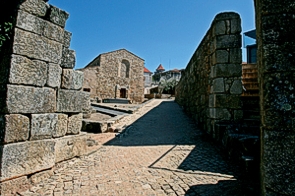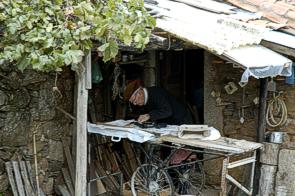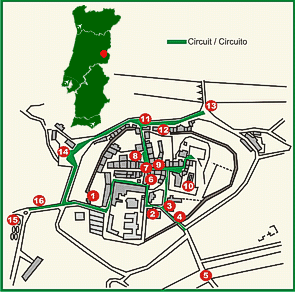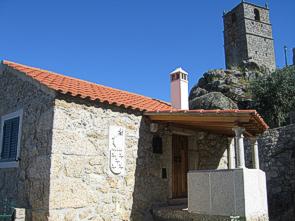
The little village of Idanha-a-Velha some 50km/31miles northeast of Castelo Branco boasts an illustrious past.
Founded by the Romans it was the episcopal see under the Visigoth's in the sixth century before sinking back into obscurity following the Moorish invasion in the eighth century.
It is said to have been the birthplace of a Visigothic king, with its own bishops at the cathedral which was restored in the beginning of the 16th century but still preserves inscribed and sculpted Roman stones.
It is worth admiring the Renaissance Mother Church, the 17th-century pillory and the ruined Templar's Tower.
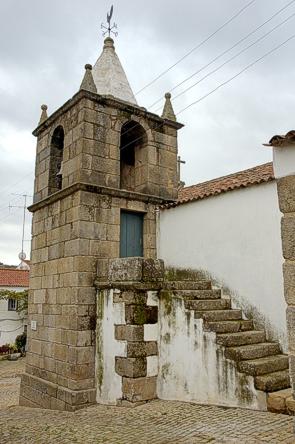
Idanha-a-Velha is a small picturesque village , consisting of a remarkable group of ruins, which holds a position of high standing among the national archaeological works. It stand on a place where formerly was a Roman City (1st century B.C.), which was inserted in "Civitas Igaeditanorum", having become a Roman Municipality later on. An inscription dating from 16 B.C., where we can read that "Quintus Iallius", a citizen from " Emerita Augusta" (Mérida) "has willingly given a sundial to Igeditanos" witnesses the existence of an urban site in those bygone days, In 105, in an inscription in Alcântara Bridge (a very important Roman engineering work) the village is referred to as one of the most important Municipalities that contributed to the Bridge's construction. Nowadays there are still a lot of evidence showing that civilization permanence: the "podium" of the temple on which the Templar's Tower stands; the Northern Gate and its wall ; one exceptional group of tomb stones and various scattered remains.
In the Visigoth Era, under the name of "Egitânea", the village witnessed golden developing times, having been a diocese seat since 599 and a gold coining center (where tridents were coined). The Baptistery, the ruins of the Bishop's Palace and the Sé are material witnesses of those golden days.
The Arabs got hold of the city until King Afonso III from Leão conquered it, during the Christian fights bit it was already an integrating part of Condado Portucalense at the time of Portugal foundation. Later one, King Alfonso Henriques delivered it to the Templar monks. In 1229, King Sancho II chartered it. King Dinis included it in "Ordem de Cristo" (1319). During the centuries, other peopling attempts followed. In 1510, King Manuel I chartered it again, the Pillory is a witness to the fact. In 1762, it was known as a small town in Castelo Branco jurisdiction; in 1811, it became attached to Idanha-a-Nova; in 1821 it became the seat of a small municipality, which still existed in 1836. Intentionally, along the centuries people tried to reorganize the urban space, revitalising it in social, economic, political and cultural fields. However, its historical desertification course was set. Nowadays, Idanha-a-Velha (considered a national monument) emerges quite renewed. A historical village wisely adapted to those who live here and to those who visit it.
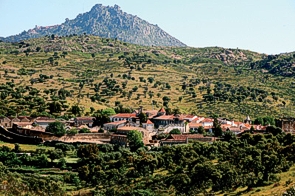
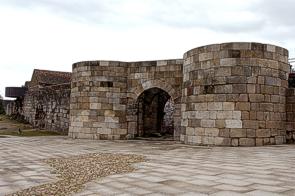
(Click on Map to Enlarge)
When you arrive in Idanha-a-Velha, you can admire the monumentality of its walls, its small towers and the Porta Nova ![]() (new doorway), which leads to the village inside. The walls reveal an oval shape 745m long with two entrances and four semicircular and three-square keeps. Idanha-a-Velho owes its building heritage to a great number of inhabitants who were established there and have adapted and reformulated spaces and buildings, along the centuries of territorial occupation.
(new doorway), which leads to the village inside. The walls reveal an oval shape 745m long with two entrances and four semicircular and three-square keeps. Idanha-a-Velho owes its building heritage to a great number of inhabitants who were established there and have adapted and reformulated spaces and buildings, along the centuries of territorial occupation.
Follow the Rua da Palma till you reach Marrocos House. This building from the 20th century belongs to a wealthy family and shows wonderful stonework on balconies and facade. Following the direction of the mulberry tree which gives name to the Square, go through the small street next to Marrocos House and turn right up to Sé Cathedral ![]() . In Rua da Sé, the rebuilding of a small dwelling allowed the settling of the Tourist Office
. In Rua da Sé, the rebuilding of a small dwelling allowed the settling of the Tourist Office ![]() , where you can see part of a Roman dwelling on which the building stands. The Sé, dating from the beginning of Christianity, with a strong intervention during the Manueline Era, incorporates a Paleo-Christian Baptistery (6th/7th centuries) on the South side of the temple; quite near, you can see the ruins of the Bishop's Palace. Close to the walls and near the Southern Gate, you find fragments of the Roman ruin of a dwelling
, where you can see part of a Roman dwelling on which the building stands. The Sé, dating from the beginning of Christianity, with a strong intervention during the Manueline Era, incorporates a Paleo-Christian Baptistery (6th/7th centuries) on the South side of the temple; quite near, you can see the ruins of the Bishop's Palace. Close to the walls and near the Southern Gate, you find fragments of the Roman ruin of a dwelling ![]() (1st/3rd centuries), which spread beyond the town walls, having been fractionated when the urban web receded (4th century).
(1st/3rd centuries), which spread beyond the town walls, having been fractionated when the urban web receded (4th century).
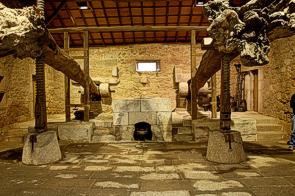
The Sé Square leads to Lagar de Vares ![]() (Oil Press), an important building in industrial archaeology, which witnesses how the community is able to profit from resources and transform the region's agricultural products. This recently rebuilt space shows a first room with two great pressing bars and a boiler; in the next room you can see the olive tank and the milling place. In the yard where the wall that fed the boiler stands, they built a modern structure to show one of the most important Roman epigraphic collection in "Peninsula Iberia".
(Oil Press), an important building in industrial archaeology, which witnesses how the community is able to profit from resources and transform the region's agricultural products. This recently rebuilt space shows a first room with two great pressing bars and a boiler; in the next room you can see the olive tank and the milling place. In the yard where the wall that fed the boiler stands, they built a modern structure to show one of the most important Roman epigraphic collection in "Peninsula Iberia".
Go up to the end of the street and climb up to the Tower. The Templar Tower ![]() , a military building from the 13th century, was erected on the podium of the Roman forum (1st century). This is what was left from the Roman temple, possibly devoted to Venus. From this highest point, you get an exceptional view over the whole village. The Spa premises, with a vast structure the makes people think the place had formerly been a public building, stands on the south side of the Forum.
, a military building from the 13th century, was erected on the podium of the Roman forum (1st century). This is what was left from the Roman temple, possibly devoted to Venus. From this highest point, you get an exceptional view over the whole village. The Spa premises, with a vast structure the makes people think the place had formerly been a public building, stands on the south side of the Forum.
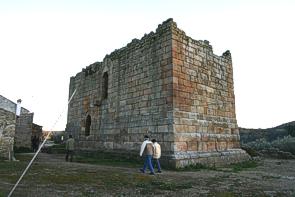
Take Rua do Castelo (Castle St.) and notice the recently rebuilt communal oven ![]() and then follow to Mother Church. The Pillory Square marks the point where two main structuring village axes cross and where you will find important elements of civic and religious interest: The Pillory
and then follow to Mother Church. The Pillory Square marks the point where two main structuring village axes cross and where you will find important elements of civic and religious interest: The Pillory ![]() , built in Manueline style, the Town Hall and the Mother Church. Having formerly been a Mercy Church, the Mother Church
, built in Manueline style, the Town Hall and the Mother Church. Having formerly been a Mercy Church, the Mother Church ![]() shows Renaissance style (18th century) with some popular influences.
shows Renaissance style (18th century) with some popular influences.
São Dâmaso Chapel ![]() in the Mannerist style (1748), stands outside the walls, next to the Archaeology Office. This Office works in a recently restored building, sited on the place where the Old São Dâmaso Straw Lofts
in the Mannerist style (1748), stands outside the walls, next to the Archaeology Office. This Office works in a recently restored building, sited on the place where the Old São Dâmaso Straw Lofts ![]() once stood. In this place, excavation work discovered part of the city wall and a small tower.
once stood. In this place, excavation work discovered part of the city wall and a small tower.
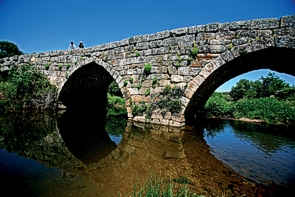
Looking over the Pônsul River, you will find the Roman Bridge ![]() an important link in the road between " Mérida" (Emérita Augusta) and "Braga" (Bracara Augusta), which suffered several reconstruction works during the Middle Ages. On the fertile riverbanks we can see the village vegetable plots, quite important for the people's survival.
an important link in the road between " Mérida" (Emérita Augusta) and "Braga" (Bracara Augusta), which suffered several reconstruction works during the Middle Ages. On the fertile riverbanks we can see the village vegetable plots, quite important for the people's survival.
The Holy Ghost St. makes you go round the outside of the wall until you reach the Square and the Holy Ghost Chapel ![]() . This small Mannerist Chapel was built in the 16th/17th centuries. In the middle of May,. this place witnesses the traditional feast in honour of the Holy Ghost. Turning left, notice the 19th century São Sebastião Chapel
. This small Mannerist Chapel was built in the 16th/17th centuries. In the middle of May,. this place witnesses the traditional feast in honour of the Holy Ghost. Turning left, notice the 19th century São Sebastião Chapel ![]() .
.
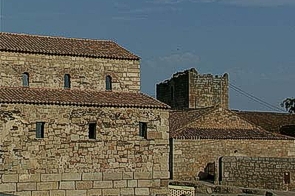
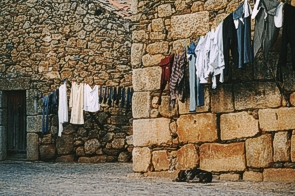
Lion House (Casa de Leão - Selfcatering)
12 km from Idanha-a-Velha. The house is located inside the walls of the historic village of Monsanto. This is an exclusive and luxurious antique house, decorated with original 18th century furniture. The house has a Bedroom, living room, dining room/single bedroom, bathroom and kitchen. There are splendid view from the windows. Capacity: 2 - 3 Persons.
Cave House (Casa da Gruta - Selfcatering)
12 km from Idanha-a-Velha. A stunning rustic stone house located inside the walls of Monsanto. It has a double bedroom and a bathroom and is decorated with original 17th century furniture. Capacity: 2 Persons.
Cafés
- Café Egitaniense: Largo da Igreja, 8. Tel: 277 914 112
- Café LAFIV: Largo da Amoreira, 1. Tel: 277 914 180
Festival
- Holy Ghost Festival - Middle of May
Services
- Tourist Office: Rua da Sé. Tel: 277 914 280. Opening times: 10am - 12.30pm / 2pm - 6.30pm
- Administrative Office: Idanha-a-Velha. Tel: 277 914 263
- Health Center: Idanha-a-Velha. Tel: 277 914 112
